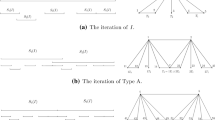Abstract
Let \(\lambda _{1},\ldots ,\lambda _{n}\) be real numbers in \((0,1)\) and \(p_{1},\ldots ,p_{n}\) be points in \(\mathbb {R}^{d}\). Consider the collection of maps \(f_{j}:\mathbb {R}^{d}\rightarrow \mathbb {R}^{d} \) given by
It is a well known result that there exists a unique nonempty compact set \(\Lambda \subset \mathbb {R}^{d}\) satisfying \(\Lambda =\cup _{j=1}^{n} f_{j}(\Lambda ).\) Each \(x\in \Lambda \) has at least one coding, that is a sequence \((\epsilon _{i})_{i=1}^{\infty }\in \{1,\ldots ,n\}^{\mathbb {N}}\) that satisfies \(\lim _{N\rightarrow \infty }f_{\epsilon _{1}}\ldots f_{\epsilon _{N}} (0)=x.\) We study the size and complexity of the set of codings of a generic \(x\in \Lambda \) when \(\Lambda \) has positive Lebesgue measure. In particular, we show that under certain natural conditions almost every \(x\in \Lambda \) has a continuum of codings. We also show that almost every \(x\in \Lambda \) has a universal coding. Our work makes no assumptions on the existence of holes in \(\Lambda \) and improves upon existing results when it is assumed \(\Lambda \) contains no holes.
Similar content being viewed by others
References
Akiyama, S., Komornik, V.: Discrete spectra and pisot numbers. J. Number Theory 133(2), 375–390 (2013)
Broomhead, D., Montaldi, J., Sidorov, N.: Golden Gaskets: Variations on the Sierpiński Sieve. Nonlinearity 17(4), 1455–1480 (2004)
Dajani, K., de Vries, M.: Invariant densities for random \(\beta \)- expansions. J. Eur. Math. Soc. 9(1), 157–176 (2007)
Dajani, K., Kalle, C.: Random \(\beta \)- expansions with deleted digits. Discrete Contin. Dyn. Syst. 18(1), 199–217 (2007)
Daróczy, Z., Katai, I.: Univoque sequences. Publ. Math. Debrecen 42, 397–407 (1993)
Erdős, P., Joó, I., Komornik, V.: Characterization of the unique expansions \(1 =\sum _{i=1}^{\infty }q^{-n_{i}}\) and related problems. Bull. Soc. Math. Fr. 118, 377–390 (1990)
Erdős, P., Komornik, V.: Developments in non-integer bases. Acta Math. Hungar. 79(1–2), 57–83 (1998)
Falconer, K.: Mathematical foundations and applications, p. 368. Wiley, Chichester (2014). (ISBN: 978-1-119-94239-9 28-01)
Falconer, K.: The Hausdorff dimension of some fractals and attractors of overlapping construction. J. Statist. Phys. 47(1–2), 123–132 (1987)
Feng, D.J.: On the topology of polynomials with bounded integer coefficients. arXiv:1109.1407 [math.NT]
Glendinning, P., Sidorov, N.: Unique representations of real numbers in non-integer bases. Math. Res. Letters 8, 535–543 (2001)
Hutchinson, J.: Fractals and self-similarity. Indiana Univ. Math. J. 30(5), 713–747 (1981)
Jordan, T., Pollicott, M.: Properties of measures supported on fat Sierpinski carpets. Ergodic Theory Dynam. Syst. 26(3), 739–754 (2006)
Keane, M., Smorodinsky, M., Solomyak, B.: On the morphology of \(\gamma \)- expansions with deleted digits. Trans. Amer. Math. Soc. 347(3), 955–966 (1995)
Kigami, J.: Analysis on fractals, Cambridge Tracts in Mathematics, vol. 143. Cambridge University Press, Cambridge, p. 226. ISBN: 0-521-79321-1 (2001)
Komornik, V., Lai, A.C., Pedicini, M.: Generalized golden ratios of ternary alphabets. J. Eur. Math. Soc. (JEMS) 13(4), 1113–1146 (2011)
Komornik, V., Loreti, P.: Unique developments in non-integer bases. Amer. Math. Monthly 105(7), 636–639 (1998)
Parry, W.: On the \(\beta \)- expansions of real numbers. Acta Math. Acad. Sci. Hung. 11, 401–416 (1960)
Pedicini, M.: Greedy expansions and sets with deleted digits. Theoret. Comput. Sci. 332(1–3), 313–336 (2005)
Pollicott, M., Simon, K.: The Hausdorff dimension of \(\lambda \)- expansions with deleted digits. Trans. Amer. Math. Soc. 347(3), 967–983 (1995)
Rényi, A.: Representations for real numbers and their ergodic properties. Acta Math. Acad. Sci. Hung. 8, 477–493 (1957)
Sidorov, N.: Almost every number has a continuum of \(\beta \)- expansions. Amer. Math. Monthly 110(9), 838–842 (2003)
Sidorov, N.: Combinatorics of linear iterated function systems with overlaps. Nonlinearity 20(5), 1299–1312 (2007)
Sidorov, N.: Universal \(\beta \)- expansions. Period. Math. Hungar. 47, 221–231 (2003)
Simon, K., Solomyak, B.: On the dimension of self-similar sets. Fractals 10(1), 59–65 (2002)
Solomyak, B.: Notes on Bernoulli convolution. Proc. Symp. Pure Math. 72(1), 207–230 (2004) (American Mathematical Society)
Acknowledgments
The author would like to thank Tom Kempton and Nikita Sidorov for useful discussions. This work was supported by the Dutch Organisation for Scientic Research (NWO) Grant Number 613.001.022.
Author information
Authors and Affiliations
Corresponding author
Additional information
Communicated by H. Bruin.
Rights and permissions
About this article
Cite this article
Baker, S. On the cardinality and complexity of the set of codings for self-similar sets with positive Lebesgue measure. Monatsh Math 179, 1–13 (2016). https://doi.org/10.1007/s00605-015-0755-2
Received:
Accepted:
Published:
Issue Date:
DOI: https://doi.org/10.1007/s00605-015-0755-2



